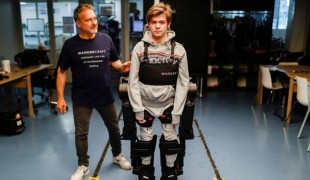- 5539
- 463
- 9
- 6
- 0
- Help Ukraine
About the solution
Graham Naylor, a graphic designer, born in 1972, is an extreme-sports fan who lost the use of both of his legs in 2012, after being caught in an avalanche. Graham was buried so deep in snow that the oxygen didn’t reach his brain, leading to action myoclonus (an injury to the part of the brain that controls motor functions, swallowing, speech and limb movement).
Now the designer relies on his caregiver for a lot of tasks in his daily routine. “Roy has to chop up anything I eat and I have to smother everything in oil and sauces to help food slide down without choking, I look like a seal swallowing mackerel. Everything is a bit of a battle, but I try to stay positive and I still believe in mind over matter – come on legs, move!”, he said.
Graham has difficulty standing and has limited arm movement. His dream is to go back to the mountains. “But the one thing I liked more than anything was escaping up a mountain. It was probably the only thing I’ve ever excelled at. When the show came to my ‘disabled only’ gym, I suggested trying to snowboard – jokingly, thinking that they’d never go for it. I was just hoping to get that flying feeling again”, the man observed.
Yusuf and Graham met at the Big Life Fix. Yusuf is also a snowboarder. “It made sense to me – revisiting the mountain and trying to conquer it again. “We had a session at an indoor snow centre where Graham struggled just to stand on a board for a few seconds. The prospect of finding a solution that worked was daunting”, the engineer explained.
The inventor built sturdy crutches that fastened to the board to allow Naylor to control his movements with his arms. He took his hand-welded design to snowboard company Burton, which created a prototype.
Yusuf believes this design offers a new way of utilising a snowboard as a rehab tool for people trying to stand. He now hopes to find a manufacturer who wants to take it to market. “And I’m still in contact with Graham – he’s such a good laugh and so enthusiastic, it’s hard not to get swept up in his ideas.”
Adapted from: https://bit.ly/2LZAAPW
More info: http://www.yusufm.com/project5.html
https://www.youtube.com/watch?v=NCT7ltEV9tg
This solution shall not include mention to the use of drugs, chemicals or biologicals (including food); invasive devices; offensive, commercial or inherently dangerous content. This solution was not medically validated. Proceed with caution! If you have any doubts, please consult with a health professional.
DISCLAIMER: This story was written by someone who is not the author of the solution, therefore please be advised that, although it was written with the utmost respect for the innovation and the innovator, there can be some incorrect statements. If you find any errors please contact the patient Innovation team via info@patient-innovation.com
-
-
398
-
0
-
5544

Father creates exoskeleton to help son with genetic neurological condition walk
BODY BALANCE: Maintaining body balance
STANDING UP: Standing up from a seated position
WALKING WITH A WALKING AID: Walking with a walking aid
CAREGIVING
Cervical spinal cord injury/Tetraplegia
Assistive Technology access
Walking Aid (wheelchair/walker/crutches)
Restoring mobility
Managing pain
Promoting self-management
Preserving Organ Function
Managing Neurological Disorders
Recovering from Traumatic Injuries
Maintaining Balance and Mobility
Restoring Blood Circulation
To improve Treatment/Therapy
Preventing (Vaccination, Protection, Falls, Research/Mapping)
Raise awareness
Caregiving Support
General and Family Medicine
Intensive Care Medicine
Neurology
Physical Medicine and Rehabilitation
Sports Medicine
France
-
-
-
545
-
0
-
8918

Man creates device to help to put on socks, shoes and even trousers
Grip
(SELF)-CARE: DRESSING: Dressing independently.
BODY BALANCE: Maintaining body balance
STANDING UP: Standing up from a seated position
Knee Deformity
Assistive Daily Life Device (to help ADL)
Strategy/Tip
Muscle weakness
Limited range of motion
Muscle pain or stiffness
Reduced grip force (grip)
Loss of muscle coordination
Muscle cramps or spasms
Joint deformity
Joint redness or warmth
Swelling or inflammation
Difficulty bearing weight
Muscle twitching
Difficulty standing from a seated position
Difficulty getting up from the floor
Numbness or tingling in the extremities
Joint pain or swelling
Restoring mobility
Promoting self-management
Preserving Organ Function
Rehabilitating After Stroke
Managing Neurological Disorders
Recovering from Traumatic Injuries
Maintaining Balance and Mobility
Preventing (Vaccination, Protection, Falls, Research/Mapping)
Caregiving Support
Internal Medicine
Neurology
Orthopedics
Physical Medicine and Rehabilitation
Rheumatology
Sports Medicine
Vascular Surgery
United States
-
-
-
638
-
0
-
9391

Father creates special crutches to help his daughter
WALKING WITH A WALKING AID: Walking with a walking aid
STANDING UP: Standing up from a seated position
BODY BALANCE: Maintaining body balance
Walking Aid (wheelchair/walker/crutches)
Restoring mobility
Promoting self-management
Managing Neurological Disorders
Promoting inclusivity and social integration
Recovering from Traumatic Injuries
Maintaining Balance and Mobility
To improve Treatment/Therapy
Preventing (Vaccination, Protection, Falls, Research/Mapping)
Orthopedics
Pediatrics
Physical Medicine and Rehabilitation
Mobility issues
Pediatric Innovations
Solutions for Disabled people
United States
-
 en
en